ASRock 890FX Deluxe: Comprehensive Motherboard Review & Investigation of Thuban Performance Scaling
by Rajinder Gill on August 31, 2010 7:00 AM EST- Posted in
- ASRock
- AMD
- Motherboards
- 890FX
We now follow up with our usual system evaluation suit to test ASRock 890FX Deluxe 4 and pit it against ASUS M4A89GTD Pro/USB3 . For this part of the test, we enabled all the power-saving features of our 1090T and Turbo Core, and Windows power plan was set to “Balanced”. We matched the 4x2GB of Corsair XMS3 sticks to DDR3-1600/7-8-7-1T on both boards using 3:12 (1:4) divider. All games were tested at their maximum graphics quality settings available in-game. Anti-aliasing was set to 4xAA when applicable, and anisotropic filtering was set to 16xAF in Catalyst Control Panel.
Application Performance - WinRAR 3.90 64-bit
This benchmark compresses our AT workload consisting of a main folder that contains 954MB of files in 15 subfolders. The result is a file approximately 829MB in size.
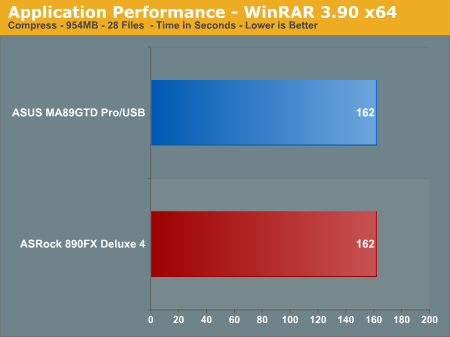
Application Performance - Bibble 5.0
We utilize Bibble Labs’ Bibble 5 v2 to convert 50 RAW image files into full size JPEG images with the program’s default settings. This program is fully multithreaded and multi-core aware.
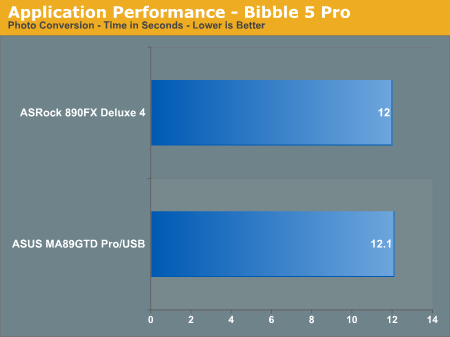
Application Performance - Sorenson Squeeze 6.0
We are using Sorenson Squeeze to convert eight AVCHD videos into HD Flash videos for use on websites. This application heavily favors physical core count and processor clock speed.
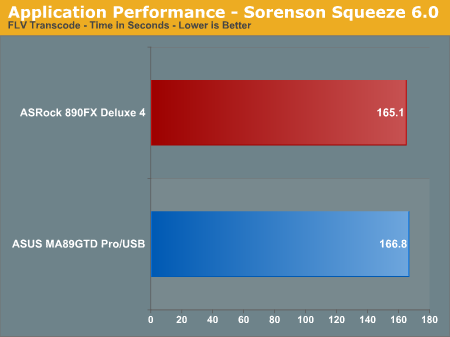
Gaming Performance - Resident Evil 5
We are using the built-in benchmark utility of Capcom's highly addictive horror game.

Gaming Performance - StarCraft 2
We use the same replay file we used in part 1, but the numbers are slightly different because here our setups are devised more closely to match actual user experience. Keep in mind that Turbo Core is enabled and memory configuration is different for this part of the test. 16AF is forced from Catalyst Control Center.
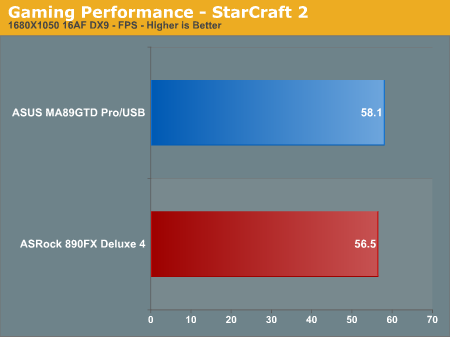
USB 3.0 Performance
We use Acronis TrueImage Home (v. 10) to make a backup of our installation drive to an external SATA 3.0 Gbps drive via USB 3.0 and compare it with USB 2.0 and SATA 3.0 Gbps transfers. The total data backed up is approximately 20 GB. We could not complete the backup on the M4A89GTD Pro/USB3 in a consistent manner.
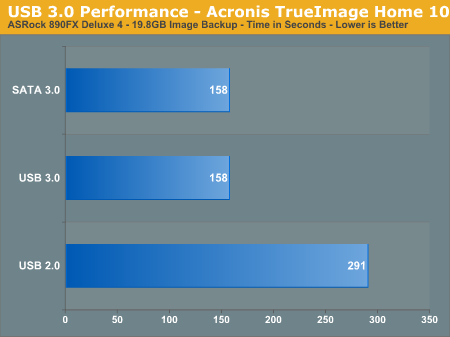










42 Comments
View All Comments
Kane Y. Jeong - Wednesday, September 1, 2010 - link
We disabled Turbo Core for maximum overclocking. vCore was measured by a DMM.softdrinkviking - Wednesday, September 1, 2010 - link
nice review, good read.one thing I noticed, in your chart comparing the 890FX and 790FX, it says "TMSC 65nm," i am thinking that should be "TMSC 45nm."
or maybe i'm crazy, or maybe both are true?
softdrinkviking - Wednesday, September 1, 2010 - link
or is that the AMD890 chipset manufacturing process that's at 65nm?pkc - Wednesday, September 1, 2010 - link
I believe that it should be compared with ASUS M4A89TD Pro/USB3 and Gigabyte GA-890FXA-UD5 which are using the same chipset i.e. 890FXMacLeod1592 - Wednesday, September 1, 2010 - link
I currently run an ASRock 780G motherboard and was hoping theyd stepped it up a notch. My board also overvolts the CPU when I overclock. Its always a notch or two higher in CPU-Z than what I set it to in the BIOS.Mines also not a great overclocker. I cant get my Athlon X3 435 over 3.4 but all the reviews Im seeing have it at 3.6 and better!
Looks like Asus will be getting my money in the near future when I upgrade mobos.
siniranji - Thursday, September 2, 2010 - link
my question is , which thuban processor will perform well with this board, i have 1055T modelMrSpadge - Saturday, September 4, 2010 - link
Can I comment now?MrSpadge - Saturday, September 4, 2010 - link
Ups, that was unexpected. On to my actual comment regarding:"We have no conclusive theory to explain this phenomenon at this time. Originally our suspicion was limited to CPU-NB’s frequencies and memory frequencies/timings, but now we wonder whether the size of L3, which is meager 1MB per core for the X6’s, comes into play as well. We are looking to further examine this subject in the future."
Naturally modern games have very complex scenes so the CPU has to deal with a lot of data. Which data is not entirely predictable & prefetchable, so the CPU absolutely needs large caches. In fact, the caches can hardly be large enough - so main memory bandwidth and latency matters.
The encoding on all 6 cores on the other hand is a very regular task and the memory requests are quite predictable. The programmer or and / the cpu prefetchers are working to keep all the data in the caches before they are needed.
Or put empirically: If the app is programmed so well that it scales well from 4 to 6 cores [your encoding does], memory access can not be a problem here. And thus faster memory doesn't help much.
Regards, MrS
geok1ng - Monday, September 6, 2010 - link
There we have it again, a seminal article that will be quoted around the web for months to come.This easy to read article is the most complete and compreensive guide to AM3 plataform overcloking, and deserves to join the now famous "why we were wrong about the P45 chipset" article on C2D memory overcloking and the SSDs series.
To give you guys an example of the importance of NB overcloking on these AMDs hexacores, Tom Hardware´s has an article on the system builders marathon today that shows a 1055T system with SLI 480s. Th build fails to impress by about 20% agains a similar priced $2000 Intel system, and guess what? TH makes no mention of NB overclock!
RealTheXev - Friday, September 10, 2010 - link
I've run into several people who have had a 8xx series AMD chipset but have run into an issue of having an SB750 southbridge instead of the SB850.http://www.starcraft2forum.org/forums/showthread.p... for my write up.
My question is, will Asus be addressing this issue by adding the SB750 to their chipset drivers? Also, will this board possible be substituted for an SB750 southbridge as well? If so, I want to know the performance difference!
Asus isn't the only manufacture substituting the southbridge. I'm curious about the difference between the SB850 and SB750 variants of these boards and how likely it is a user will end up with one of these boards "substituted" boards.